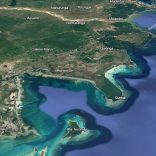Mozambique: Over 12,000 who their lost jobs after election protests still without compensation – ...
Maputo-Catembe: Two years of a bridge (still) below expectations

From its inauguration until the 30th of October, approximately 2,630,000 vehicles crossed the bridge, 89% of them light vehicles. Assuming that all of these vehicles paid the minimum fee, the government would in two years have collecteda little over 420 million meticais in tolls [about US$5.7 million at current exchange rates].. [Photo: O País]
Two million, six hundred and thirty thousand vehicles have crossed the Maputo-Catembe bridge since it opened two years ago. The number is below the National Road Fund’s projection when the infrastructure came into operation.
The bridge brought gains in the transit of vehicles and cargo across Maputo Bay, especially with regard to safety, and compared to the previous ferry scenario.
The infrastructure is said to be the longest suspension bridge in Africa, and cost US$785 million. Its contributes to socioeconomic development at both ends.
Twenty-five kilometres into Catembe, we met poultry farmer Luís Campos, who compares business before and after the opening of the bridge.
Read more: Mozambique: Is Maputo-Katembe Bridge also to be paid for with gas revenues?
“I came here more than 20 years ago, and it’s obvious that I suffered all manner of transport problems, especially during the rains. It was 20 years of suffering. The bridge has brought us fantastic mobility. I can leave the house now and be having coffee on Julius Nyerere twenty minutes later. And as a poultry farmer, just like the vegetable farmers, the transport of birds is much faster, there’s no deterioration, the road is great,” he says.
“We have a fantastic bridge, but I see it from the user’s perspective. As a resident, everything is fine. I use the bridge a lot and get a certain discount, but it is still very expensive. There are those who cannot afford to pay the toll. If they cut the toll price by half, surely investors and a lot more besides would come this way,” he adds.
Manuel Comé, a native of Catembe, moved to the capital, Maputo, and considers the bridge a great asset.
“The bridge has changed commuting a lot. We used to depend on the ferry, and would get sea-sick when the weather was bad. When it rained it was not easy. With the bridge we can come and go at will, several times a day, and safely, but I think they should reassess the toll,” the young man says.
But there are still those who prefer to cross by boat, for one common reason: the time factor.
“Where I go, it is faster to use the boat than the bridge. This is to say, we waste a lot of time waiting in the queue at the toll,” bridge user Domingos Raul says.
Read more: Mozambique opens Africa’s longest suspension bridge
Tourism development
The bridge, combined with the ring road, has considerably improved access to the beaches and Maputo Special Reserve, making the south bank of Maputo province much more accessible to tourists.
“There is no doubt that the Maputo-Catembe bridge is a very important landmark, and of crucial importance for several reasons,” says Noor Momade, president of the Association of Travel Agencies and Tour Operators of Mozambique (AVITUM).
“What interests me, of course, is the development of tourism in the area. We know that Ponta do Ouro is one of our most attractive tourist destinations, very well-known and one of the best that we have here in the country. We have a connection with South Africa which is another very important point, and in the middle of the journey we have the Maputo Special Reserve,” he observes.
Read more: Tolls announced for Maputo-Katembe bridge – Here’s what you need to know
However, despite the engineering triumph of the Maputo-Catembe bridge, now a Maputo landmark, Catembe resident and lawyer Teodoro Waty emphasises that the infrastructure must be managed in a sustainable way.
“Today Catembe is a city in miniature, and in fact there is a lot of development,” Waty notes.
Economist Inocencia Mapisse even says that people’s real income has decreased as a result of the increase in the cost of transport.
“We all expected the bridge to have a negative impact. Looking only at this aspect, the impact was not positive, people simply saw a deterioration in their standard of living,” she says.
From its inauguration until the 30th of October, approximately 2,630,000 vehicles crossed the bridge, 89% of them light vehicles. Assuming that all of these vehicles paid the minimum fee, the government would in two years have collected a little over 420 million meticais in tolls [about US$5.7 million at current exchange rates].
By Yumaina Mussane












Leave a Reply
Be the First to Comment!
You must be logged in to post a comment.
You must be logged in to post a comment.